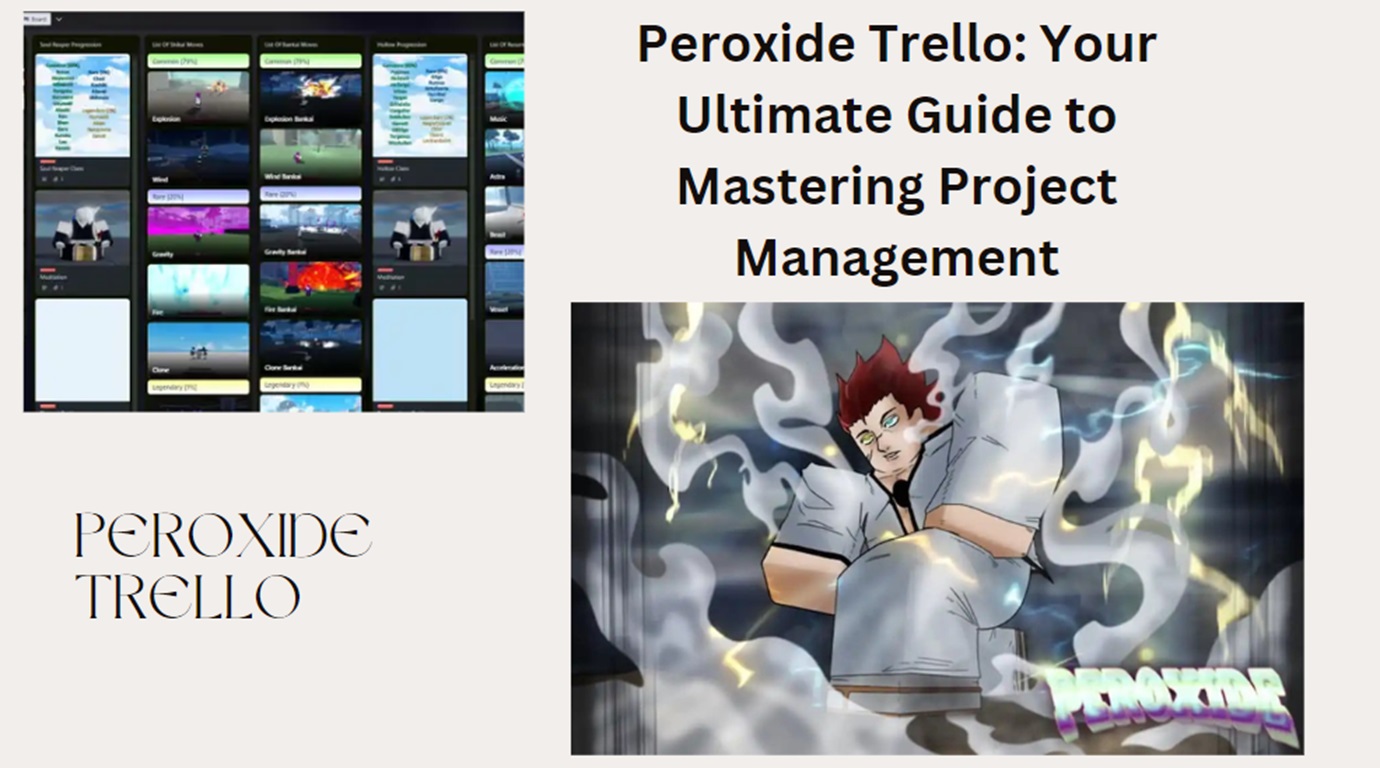
peroxide trello
Introduction
In the ever-evolving landscape of project management, tools and methodologies are continuously developed to enhance productivity, streamline processes, and improve team collaboration. One such powerful tool is Trello, a visual collaboration platform that has been widely adopted for its flexibility and ease of use. In recent years, Trello has been further enhanced with a variety of power-ups and integrations, among which Peroxide Trello stands out as a significant advancement. This comprehensive guide delves into the essentials of using Peroxide Trello for effective project management, exploring its features, benefits, and best practices to help you and your team achieve optimal results.
Table of Contents
What is Trello?
Trello is a web-based project management application created by Fog Creek Software in 2011, later spun out to form the basis of a separate company in 2014, and ultimately acquired by Atlassian in 2017. Trello uses the kanban-style list-making approach, which visualizes tasks in a board composed of lists (stages) and cards (tasks). It allows teams to collaborate on projects in a visual and straightforward manner, making it easy to track progress and manage workloads.
Introduction to Peroxide Trello

Peroxide Trello is a term used to describe the enhanced version of Trello that incorporates additional power-ups and integrations, significantly boosting the platform’s capabilities. These enhancements are designed to address specific project management needs, providing teams with more tools and functionalities to streamline their workflows.
Key Features of Peroxide Trello
- Advanced Automation: With Peroxide Trello, automation capabilities are taken to the next level. You can automate repetitive tasks, set up complex workflows, and create custom rules to ensure consistency and efficiency.
- Enhanced Reporting: Peroxide Trello offers advanced reporting features that provide in-depth insights into project progress, team performance, and resource utilization. This helps in making informed decisions and identifying areas for improvement.
- Seamless Integrations: Integration with other tools and platforms is a crucial aspect of Peroxide Trello. Whether it’s syncing with your CRM, connecting with your calendar, or integrating with communication tools like Slack, Peroxide Trello makes it seamless.
- Customizable Dashboards: Tailor your dashboards to reflect the metrics and KPIs that matter most to your project. This personalization ensures that you always have a clear view of your project’s health and status.
- Resource Management: Efficiently manage your team’s resources with features that allow you to allocate tasks based on availability, skill set, and workload. This ensures balanced workloads and optimal productivity.
- Enhanced Security: With advanced security features, Peroxide Trello ensures that your data is protected. Features like two-factor authentication, encryption, and user access controls keep your information safe.
Setting Up Peroxide Trello
Step-by-Step Guide to Getting Started
- Creating Your Account: If you don’t already have a Trello account, sign up for one. If you have an existing account, ensure it’s upgraded to access Peroxide Trello features.
- Setting Up Your Workspace: Create a new workspace or select an existing one where you want to implement Peroxide Trello.
- Creating Your First Board: Set up your first board by defining the project scope, stages, and initial tasks. Customize the board layout to suit your project management style.
- Adding Power-Ups: Enhance your Trello board by adding the necessary power-ups. This can include automation tools, reporting features, integrations, and more.
- Configuring Automation: Use Butler, Trello’s automation tool, to create rules, buttons, and scheduled commands that automate repetitive tasks and streamline workflows.
- Inviting Team Members: Add team members to your board, assign roles, and set permissions. This ensures everyone has the access they need to contribute effectively.
- Customizing the Board: Tailor your board with custom fields, labels, and checklists to organize tasks and provide additional context.
Using Peroxide Trello for Effective Project Management

Planning Your Project
Defining Project Goals and Objectives
Before diving into task management, it’s essential to clearly define the goals and objectives of your project. Use the project board to outline these elements, ensuring that all team members are aligned on the project’s purpose and desired outcomes.
Creating a Project Timeline
Set up a project timeline using Trello’s calendar view or integration with tools like Google Calendar. This helps in visualizing key milestones, deadlines, and dependencies, ensuring that the project stays on track.
Task Breakdown and Assignment
Break down the project into manageable tasks and assign them to team members. Use checklists within cards to outline sub-tasks, making it easier to track progress and ensure nothing is overlooked.
Execution and Monitoring
Real-Time Collaboration
Peroxide Trello facilitates real-time collaboration, allowing team members to comment on cards, attach files, and update statuses. This fosters communication and ensures that everyone is on the same page.
Tracking Progress
Utilize the visual nature of Trello boards to track progress at a glance. Move cards through lists as tasks progress, providing a clear visual representation of the project’s status.
Managing Dependencies
Identify and manage task dependencies using linked cards or automation rules. This ensures that tasks are completed in the correct order and helps prevent bottlenecks.
Resource Allocation
Effectively allocate resources by considering team members’ availability and workload. Use Trello’s custom fields to track resource assignments and ensure balanced workloads.
Advanced Automation
Creating Automation Rules
Leverage Trello’s Butler to create automation rules that streamline your workflow. For example, you can set up rules to move cards between lists based on due dates or trigger actions when specific criteria are met.
Custom Buttons and Commands
Create custom buttons and commands that perform specific actions with a single click. This can save time on repetitive tasks and improve efficiency.
Scheduled Automations
Set up scheduled automations to perform routine tasks at predefined intervals. This can include sending progress reports, archiving old cards, or updating due dates.
Reporting and Analysis
Utilizing Dashboards
Create customized dashboards that provide a comprehensive view of your project’s performance. Use widgets to display key metrics, such as task completion rates, team productivity, and upcoming deadlines.
Generating Reports
Generate detailed reports that analyze various aspects of your project. This can include performance reports, workload analysis, and time tracking summaries.
Data-Driven Decision Making
Use the insights gained from reports and dashboards to make informed decisions. Identify areas for improvement, allocate resources more effectively, and adjust project plans as needed.
Best Practices for Using Peroxide Trello

Maintain Clarity and Transparency
Ensure that all project information is clearly documented and easily accessible. Use clear and concise card titles, descriptions, and labels to provide context and avoid confusion.
Regularly Update the Board
Keep your Trello board up to date by regularly reviewing and updating tasks. Encourage team members to update card statuses and add comments to provide real-time insights.
Foster Collaboration
Promote collaboration by encouraging team members to actively participate in discussions and share updates. Use Trello’s commenting and file attachment features to facilitate communication.
Monitor Workload and Progress
Regularly monitor team members’ workloads and project progress to identify potential issues early. Use dashboards and reports to keep track of key metrics and ensure that the project stays on track.
Leverage Automation Wisely
While automation can significantly enhance productivity, it’s important to use it wisely. Avoid over-automating and ensure that automation rules are well-defined and aligned with your project goals.
Case Study: Successful Implementation of Peroxide Trello
Background
A mid-sized marketing agency, XYZ Marketing, faced challenges in managing multiple projects simultaneously. The team struggled with tracking progress, managing resources, and ensuring timely delivery. To address these issues, they decided to implement Peroxide Trello.
Implementation Process
- Needs Assessment: The agency conducted a thorough assessment of their project management needs and identified key pain points.
- Custom Board Setup: They created custom boards for each project, defining stages such as “To Do,” “In Progress,” “Review,” and “Completed.”
- Power-Up Integration: Key power-ups, including automation tools, reporting features, and calendar integrations, were added to enhance functionality.
- Automation Rules: Automation rules were set up to streamline workflows, such as automatically moving cards based on due dates and sending reminders for pending tasks.
- Team Training: Team members were trained on using Trello and the new power-ups, ensuring everyone was comfortable with the platform.
Results
The implementation of Peroxide Trello resulted in significant improvements:
- Enhanced Productivity: Automation reduced the time spent on repetitive tasks, allowing the team to focus on high-value activities.
- Improved Collaboration: Real-time updates and communication features fostered better collaboration and alignment among team members.
- Better Resource Management: The agency could allocate resources more effectively, balancing workloads and preventing burnout.
- Data-Driven Insights: Advanced reporting provided valuable insights, helping the agency make informed decisions and continuously improve their processes.
Conclusion
Peroxide Trello is a powerful tool that can transform the way you manage projects. By leveraging its advanced features and best practices, you can enhance productivity, improve collaboration, and achieve better project outcomes. Whether you’re a small team or a large organization, Peroxide Trello offers the flexibility and functionality needed to effectively manage your projects and drive success. Start exploring the possibilities of Peroxide Trello today and take your project management to the next level.
FAQs
- What is Peroxide Trello? Peroxide Trello is an enhanced version of Trello, offering advanced automation, reporting, and integrations for improved project management.
- How can I set up Peroxide Trello? Create a Trello account, set up your workspace and board, add power-ups, configure automation, invite team members, and customize your board.
- What are the benefits of using Peroxide Trello? Benefits include advanced automation, enhanced reporting, seamless integrations, customizable dashboards, efficient resource management, and improved security.
- Can Peroxide Trello integrate with other tools? Yes, Peroxide Trello integrates with various tools such as Google Calendar, Slack, and CRM systems, enhancing workflow and collaboration.
- Is Peroxide Trello suitable for all team sizes? Yes, Peroxide Trello is flexible and can be tailored to suit the needs of small teams and large organizations alike.




